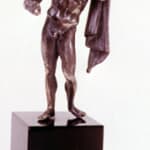Roman Silver Statuette of Jupiter, 100 CE - 300 CE
Silver
5.1 x 6.3 cm
2 x 2 1/2 in
2 x 2 1/2 in
FZ.123
This statuette created in precious silver depicts Jupiter, king of the gods of the Roman Pantheon. In keeping with his elevated status, the god is shown with a full head...
This statuette created in precious silver depicts Jupiter, king of the gods of the Roman Pantheon. In keeping with his elevated status, the god is shown with a full head of thickly curled hair, adorned with a crown. His head is turned sharply to the right with its glance cast straight ahead, as if he is momentarily scrutinizing one of his subjects. The lowered hand of his right arm holds a thunderbolt, rendered in the traditional Roman fashion, which is the exclusive attribute of Jupiter, thereby insuring the identification of this figure.
He raises his left arm high above his head and originally held a spear/lance or other long-handled attribute in its fisted hand. His mantle, or shawl, rests in the crook of that arm and serves as an artistic foil against which one can admire his beautiful body. It is for this reason that Jupiter, although a mature god, is, nevertheless, represented as a physically fit individual with prominence given to the athletic display of the rippling muscles of his torso and the well-exercised muscles of his arms and legs.
The composition of the statuette relies upon the canon perfected by Polykleitos, the renowned classical Greek sculptor of athletes in fifth century BC Greece. According to the schema developed for such depictions, which is here repeated in the composition of this silver statuette, the weight of the body is born by the erect right leg, whereas the left, non-weight bearing leg is placed to the side and back. The position of the legs enabled the sculptors to adjust the anatomy of their subject in such a way that the left arm and shoulder are elevated in contrast to the lowered right arm and shoulder. The resulting contraposto creates an artistic theater in which the muscles of the body are on display to best advantage.
Statuettes of Jupiter holding a spear or lance in one hand, with the mantle draped over the elbow, and a thunderbolt in the other were very popular in Rome, as one can imagine. Most of these were designed, as was this example, on the model provided by the canon of Polykleitos. But the group is so heterogeneous with respect to the artistic license exercised in the position of the arms, the position of the head and its crowns, and an array of other details that all must be understood as unique artistic creations which are themselves variations of one and the same theme. Many of these variations have been found in Roman Imperial sites in Gaul and Germania where their context suggests a dating within the second century AD, to which period this exquisite depiction of the king of the gods in precious metal is assigned.
References:
Heinz Menzel, “Die Jupiterstatuetten von Bree, Evreaux und Dalheim und verwandte Bronzen,” in: Toreutik und figürliche Bronzen in römischer Zeit (Berlin 1984), pages186-196; and S.
Boucher, Recherches sur les bronzes figurés de Gaule pré-romaine et romaine (Rome 1976), pages 228 and 136, for discussions of the type and its variations and their dating.
He raises his left arm high above his head and originally held a spear/lance or other long-handled attribute in its fisted hand. His mantle, or shawl, rests in the crook of that arm and serves as an artistic foil against which one can admire his beautiful body. It is for this reason that Jupiter, although a mature god, is, nevertheless, represented as a physically fit individual with prominence given to the athletic display of the rippling muscles of his torso and the well-exercised muscles of his arms and legs.
The composition of the statuette relies upon the canon perfected by Polykleitos, the renowned classical Greek sculptor of athletes in fifth century BC Greece. According to the schema developed for such depictions, which is here repeated in the composition of this silver statuette, the weight of the body is born by the erect right leg, whereas the left, non-weight bearing leg is placed to the side and back. The position of the legs enabled the sculptors to adjust the anatomy of their subject in such a way that the left arm and shoulder are elevated in contrast to the lowered right arm and shoulder. The resulting contraposto creates an artistic theater in which the muscles of the body are on display to best advantage.
Statuettes of Jupiter holding a spear or lance in one hand, with the mantle draped over the elbow, and a thunderbolt in the other were very popular in Rome, as one can imagine. Most of these were designed, as was this example, on the model provided by the canon of Polykleitos. But the group is so heterogeneous with respect to the artistic license exercised in the position of the arms, the position of the head and its crowns, and an array of other details that all must be understood as unique artistic creations which are themselves variations of one and the same theme. Many of these variations have been found in Roman Imperial sites in Gaul and Germania where their context suggests a dating within the second century AD, to which period this exquisite depiction of the king of the gods in precious metal is assigned.
References:
Heinz Menzel, “Die Jupiterstatuetten von Bree, Evreaux und Dalheim und verwandte Bronzen,” in: Toreutik und figürliche Bronzen in römischer Zeit (Berlin 1984), pages186-196; and S.
Boucher, Recherches sur les bronzes figurés de Gaule pré-romaine et romaine (Rome 1976), pages 228 and 136, for discussions of the type and its variations and their dating.
Literature
V1



